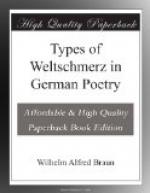If we attempt a classification of Weltschmerz with regard to its essence, or, better perhaps, with regard to its origin, we shall find that the various types may be classed under one of two heads: either as cosmic or as egoistic. The representatives of cosmic Weltschmerz are those poets whose first concern is not their personal fate, their own unhappiness, it may be, but who see first and foremost the sad fate of humanity and regard their own misfortunes merely as a part of the common destiny. The representatives of the second type are those introspective natures who are first and chiefly aware of their own misery and finally come to regard it as representative of universal evil. The former proceed from the general to the particular, the latter from the particular to the general. But that these types must necessarily be entirely distinct in all cases, as Marchand[3] asserts, seems open to serious doubt. It is inconceivable that a poet into whose personal experience no shadows have fallen should take the woes of humanity very deeply to heart; nor again could we imagine that one who has brooded over the unhappy condition of mankind in general should never give expression to a note of personal sorrow. It is in the complexity of motives in one and the same subject that the difficulty lies in making rigid and sharp distinctions. In some cases Weltschmerz may arise from honest conviction or genuine despair, in others it may be something entirely artificial, merely a cloak to cover personal defects. Sometimes it may even be due to a desire to pose as a martyr, and sometimes nothing more than an attempt to ape the prevailing fashion. To these types Wilhelm Scherer adds “Muessiggaenger, welche sich die Zeit mit uebler Laune vertreiben, missvergnuegte Lyriker, deren Gedichte nicht mehr gelesen werden, und Spatzenkoepfe, welche den Pessimismus fuer besonderen Tiefsinn halten und um jeden Preis tiefsinnig erscheinen wollen."[4]
But it is with Weltschmerz in its outward manifestations as it finds expression in the poet’s writings, that we shall be chiefly concerned in the following pages. And here the subdivisions, if we attempt to classify, must be almost as numerous as the representatives themselves. In Hoelderlin we have the ardent Hellenic idealist; Lenau gives expression to all the pathos of Weltschmerz, Heine is its satirist, the misanthrope, while in Raabe we even have a pessimistic humorist.




